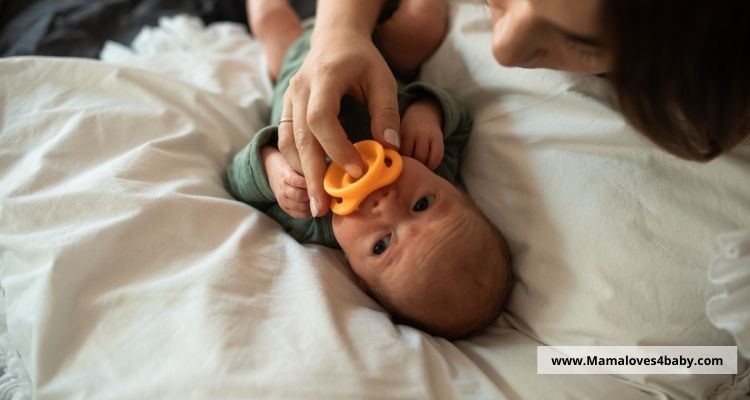It’s a common question: “How to make pacifier stay in mouth?” But how can you keep your infant from suckling on the pacifier? One method to solve this issue is to play a little game of reverse psychology. If your baby seems to be sucking on the pacifier, try gently pulling it out of his mouth. Then he’ll naturally resist the pull and suck harder on it.
However, the truth is that a pacifier is a valuable tool that a parent can use to help their baby through various difficult situations. For example, it can help your little infant cope with tummy aches, irritable bowels, and uncomfortable diapers. It can also help your baby when they are unable to soothe themselves.
Pacifier reduces Sudden infant death syndrome
According to a new study, using a pacifier while sleeping may reduce the chances of sudden infant death syndrome (SIDS) by 90 per cent in babies.

A pacifier is a foreign object for your baby. It tastes like plastic and may not be appealing to them at first. In some cases, it takes a few tries for the baby to accept the pacifier. However, the chances of your baby taking the pacifier are high. It can be the most challenging part of the process. If you go along with the steps in this article, you’ll be able to help your child accept the suckling device.
How to make pacifier stay in mouth?
While baby pacifiers can be an effective means of soothing a fussy baby, it is not the only way to do so. You can also offer comfort with extra hugs or singing lullabies. But, if you have the correct method, pacifiers can stay safely in a child’s mouth during a nap or sleep. So, there are some strategies that you can use to learn how to make a pacifier stay in baby’s mouth.
1. Don’t try to force the pacifier
Baby can’t keep pacifier in mouth? You should not try to force the pacifier into your baby’s mouth, as this will cause your baby an emotional crutch on it. You can also encourage your baby to latch onto a pacifier by gently tugging it out of their mouth when they are sucking. While this will initially be tricky, your child will most likely strong suck and pull the pacifier back in if you try to put it back.

2. Introduce the pacifier in a fun way
Once your baby can grasp the concept of sucking on a pacifier, you can introduce it to your baby in a fun way. It’s best to offer a pacifier to your child when they are calm and happy. Pacifier helps in building your child’s muscle memory, remain active and help her hold the pacifier longer.
3. Understand your baby’s pacifier needs
Why can’t my baby keep a pacifier in his mouth? Primarily you need to get your baby used to suck on a pacifier. Once you’ve mastered this process, your child will start sucking on the pacifier without much help. I believe new parents must understand their baby’s pacifier’s needs and their pacifier’s age.
Although it is difficult, after recognizing it, you can use the best pacifier in various shapes and positions, depending on your baby’s size and age. It’s important to remember that the suckling process will last a few days and can last a few weeks. If your baby is too young to latch on to a pacifier, you can also use multiple pacifiers. Therefore, better to observe the baby’s cues.
4. Check for proper fit
The other thing parents should do when trying to make a pacifier stay in their baby’s mouth is to make sure that the nipple is of the correct size to fit correctly in the child’s mouth. Next, the nipple must be on the side. If the nipple is on the outside, your baby will not see it and will not get it back. To avoid nipple confusion and rejection, use the most natural, soft, and silicone pacifiers, especially for older babies.
5. Give a pacifier when the baby cries
Pacifiers are tempting. When your baby is wailing, don’t force it. No one appreciates having an unknown object shoved into their mouth when they are upset. While the pacifier is excellent for soothing your child and helping his deep sleep, you should only introduce it when your child cries or is colicky. If you try introducing the pacifier too early or too often, your baby may become resistant.
6. Tugging on the pacifier gently
The most crucial thing is to know what your young infants will tolerate and will not put it back in the mouth. You can try this by gently tugging on the pacifier. It will encourage your baby to suck harder and help establish a good latch. You may also find that your infant pushes out the suckling portion of the pacifier during the night, so be prepared to remove it when your baby is ready to fall asleep.
7. Pacifier safety with best pacifier clips

Many beautiful designed baby pacifiers clips are available in the market attached with stuffed animals. It will help secure your baby’s pacifier to anywhere on clothing. They will serve to prevent pacifiers from falling and getting unhygienic. Pacifier quickly helps soothe when baby sick and cries. Their soft, colourful ribbons will make them appealing to your little one. Therefore, these are best if your baby’s pacifier keeps falling out.
8. Use a bib
To make a pacifier safe stay in a child’s mouth, you should use a bib. This will catch the baby’s spits and prevent the pacifier from being lost or damaged. Baby bibs are another way to keep a pacifier in your baby’s mouth. They are designed to help your baby feel safe and secure. If your baby rejects a pacifier, you should try it.
Is your baby suddenly refusing pacifier?
A binky can be an excellent comfort for your baby. Although you may feel anxious or panicky when your baby starts refusing to accept it, so how to keep a pacifier in a baby’s mouth. The pacifier is there to make your life easier. The pacifier can help soothe your child and make you feel calm. If you are facing difficulty getting your baby to take a suckling device, try giving it a try when he is clear and not crying.

Tip:
Parents should also avoid giving their babies a pacifier when they don’t need it. It is a non nutritive sucking that sometimes causes ingestion of air bubbles and can also lead to a dangerous pacifier habit.
Not all babies readily accept a pacifier. It can be a daunting experience for a new parent to discover that their baby resists taking a pacifier. Still, there are ways to encourage your child to accept the pacifier.
So, how to keep pacifier in newborn mouth? One way is to introduce it at the right time. If your baby can’t keep pacifier in mouth and cries at the first attempt, try a pacifier in the baby’s mouth when he’s calm and relaxed. So the likelihood of your baby taking it is increased. If your baby refuses the pacifier, make a special effort to reassure him and avoid frustration.
Is your baby wakes up every time pacifier falls out?
While using a pacifier for a baby’s first teething isn’t always safe, there are some techniques to save your baby from becoming addicted to pacifiers. You should first make sure your pacifier is safe to use. Safety standards are essential for a pacifier. If it doesn’t pass these tests, don’t use it.
But How to put your baby tonight sleep without a pacifier? When your baby wakes up every time the pacifier falls out, you probably feel bad. Babies can be fussy at this stage, so you should be able to find a solution to your problem in no time. The first step in putting your baby to sleep at night without a pacifier is to give your child the pacifier before bed.

The pacifier plays an essential role in your baby’s sleep. Despite what you may think, it’s easy to make this object a prop. It will fall out of your baby’s mouth when he’s deep asleep, and you’ll have to wake him up to get it back. But that doesn’t mean that you should remove the pacifier as soon as your baby wakes up. There are ways to keep the numbing device in your child’s mouth without waking him up.
The first step in putting your baby to sleep without a pacifier is to teach your baby to replace the pacifier independently. When your baby has mastered replacing the nipple, he will be able to do it by himself. He will recognize that he needs to suck it in, which is a great way to help him fall back asleep.
Conclusion
Keeping a pacifier in your baby’s mouth can be a difficult challenge, but it is worth it. Self-soothing eliminates the risk of SIDS, diaper change, night wean, sleep, next feeding etc. Most parents use techniques to make a pacifier stay in their baby’s mouth without difficulty. While giving your baby the best pacifier during distress may seem tempting, be sure not to use it when your child is unhappy. Many Babies cries for different reasons, and it is essential to remember to use the pacifier only for these reasons. At the same time, your baby may be able to take a pacifier in his mouth once it’s happy and relaxed.
I hope by following these guidelines, you have learned how to keep pacifier in baby’s mouth, thus your child will be happy to accept the pacifier and be able to self-soothe. You’re good to go if they latch on nicely to the nipple.


